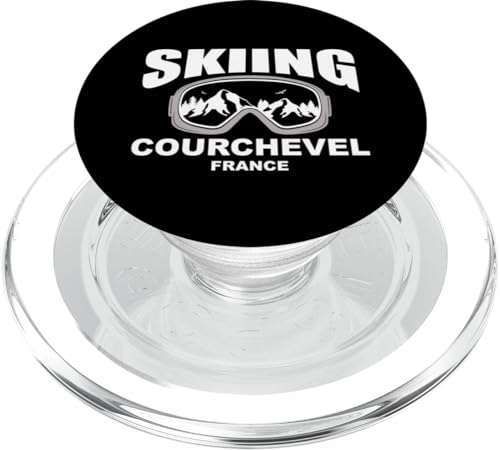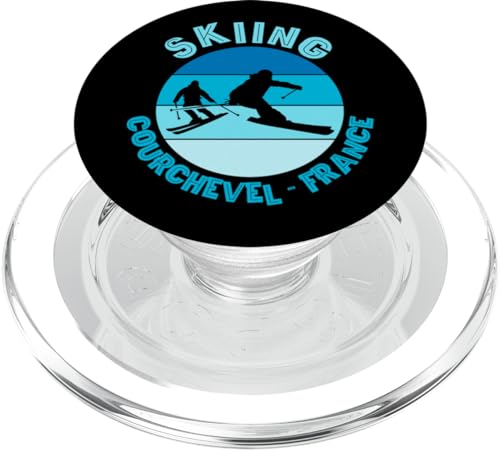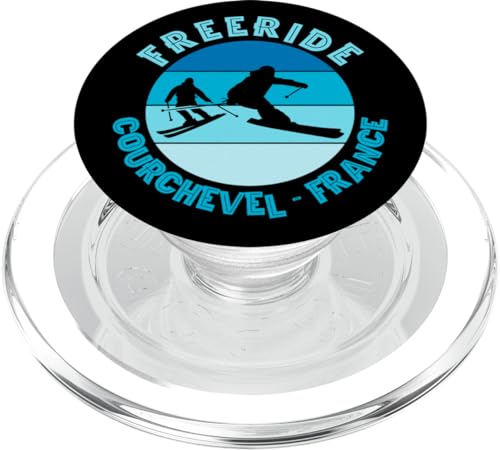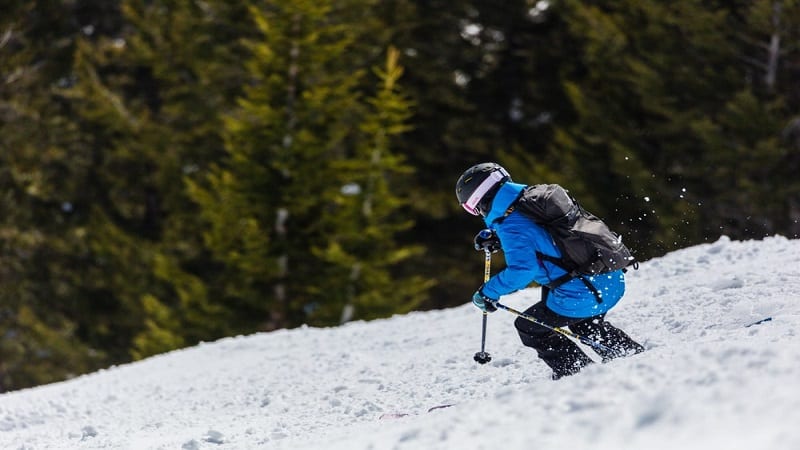Skiing is an adventure sport and has different modalities. Practice is a prerequisite before trying out a new ski discipline and requires a thorough analysis of every aspect and element associated with it. Even skiing enthusiasts who have experience in one type of ski modality cannot try a new one without being clear about the discipline, materials, and right techniques to employ.

In this regard, this article intends to answer the question, what is alpine skiing? Began to be practiced in the Alps, alpine skiing is the sports discipline or ski modality that includes downhill and slalom in which a person slides down a rough downhill through the snow in a controlled way. It has its own rules, differences and risks, which one needs to know before giving it a try.
Let’s delve into the world of alpine skiing and explore everything you need to know about this snow adventure!
What is Alpine Skiing?
Alpine skiing, named for the location of its origin and also known as downhill skiing, is one of the best-known modalities within competition skiing and one of the most practiced disciplines of winter sports. It began to be practiced in the Alps, a region with a long tradition in snow sports and consists of descending an uneven ski slope. The main objective of this sport is to descend in the shortest time possible, following a route ‘marked’ with different types of signals.
Alpine skiing generally is at high altitudes, above the tree line, in a secluded location. But the word has evolved over the years and now refers to very high mountains, especially those with treeline boundaries. The treeline defines the elevation at which trees can no longer grow due to height. There are then large open and wild expanses almost covered with rocks, ice or snow.
Powder or Groomed Slopes?
There are groomed trails even in an alpine area. Some ski resorts poke the slopes up and down the mountain. Still, in the case of alpine skiing, those slopes are for access and safety, rather than recreation, to allow skiing enthusiasts to find a place to explore or, in other words, a place to think outside the box and venture. The groomed tracks also provide a safe route back down in case skiers change their mind about off-piste or if someone is left alone or with a minor injury. Of course, in the event of a major injury in an isolated location, it is essential to seek help before descending.
Once on the slopes, the fun begins. Alpine skiing has its equipment and techniques, including longer and wider skis for powder and much more insulated clothing for more difficult conditions. You will need to learn to stay on top of the snow, navigate through the mountain without markings or tracks, and avoid hidden obstacles like cliffs and rocks. The rewards are incredible. The views are amazing, and the skiing itself is nothing like what you may have experienced.
How do Skiers Access the High Mountains for Alpine Skiing?
There are two main ways to access the high mountains. The first and most common is the use of cable cars or chairlifts. The second is transport by helicopter. The second solution is generally reserved for experts, or even professionals, much more expensive and more difficult.
It is recommended never to go alpine skiing alone. And under no circumstances should you travel to the high mountains without the advice of a local expert and the proper equipment in the event of an emergency. You will be tempted to go on your own, but you need a local guide for your first outings on an unfamiliar mountain.
The Alpine Ski Competition Track
During competitions, it is an obligation that the track is homologated by the FIS (International Ski Federation). This means that it must be properly marked since skiers reach speeds of up to 165 km/h and that any obstacle out of place can be deadly. These signs or fences must be flexible to act as a brake in the event of a fall.
Another important factor is the quality of the snow. It must be hard and compact. If the conditions do not occur naturally, chemical products leave them in optimum condition before the competition.
Alpine Skiing Specialties
As in all forms of skiing, it is required, in addition to being in good shape, certain physical and technical skills that will depend on each of the existing specialties. In the Winter Olympic Games program, there are up to 5 alpine skiing specialties in men’s and women’s categories.
Descent
The objective is to go down a snowy mountain in the shortest time possible, and it is the most followed event in the World Cup. It consists of making the descent in the shortest route time, which is usually an average of between 1 minute and a half and two and a half minutes.
This test is done in three days. On the first day, the participants study and walk the track. On the second day, they make a training descent to increase the speed and improve the times for the third day to dedicate it to the competition.
Slalom
To practice this modality, you need a great ability to perform tight turns. This test consists of doing two rounds with different routes in the shortest possible time. The route is the shortest, with a greater number of doors and less distance between doors. It is necessary to have great precision and coordination to perform this exercise successfully since the athletes make more closed turns.
Giant Slalom
Same as slalom but with a longer course and greater distance between doors. It takes a higher speed, and its turns are wider.
Super Giant Slalom
The intermediate route between the previous 2 in terms of distance, Super Giant Slalom has a negative slope similar to the descent. But the biggest difference is that this discipline does not allow such a wide recognition of the route.
Parallel
In this test, the runners descend a short route, often in pairs and compete to be the first to reach the finish line. Although it is the least practiced, it is very attractive to the public since competition between the skiers causes a certain tension and emotion.
Combined
This test is carried out in two parts, one for Downhill and another for Slalom as independent, but in two rounds. The winner is the one whose sum of both times is less.
The Mountain Code of Conduct
The ski slopes are a huge playground, but it is important to follow certain rules of conduct to ensure the safety of everyone. The Code of Conduct is posted at the ski resort ticket office and near the pier of each ski lift and applies to anyone who practices a sliding sport: downhill skiing or snowboarding. The ski resort managers can withdraw your day ticket or your season pass if you do not obey these rules. Remember to stay alert and pay close attention to what is going on around you. No matter your caliber, the important thing is to avoid reckless behavior, control your speed and watch your line of descent.
Ski Lessons
It is advisable to take a lesson with an instructor when trying alpine skiing for the first time. Ski lessons allow you to adopt the right techniques to start on a good basis. Skiers often start with the snowplow technique on the green/blue slopes and learn to control their speed, balance and direction. Then you will perform a series of turns, followed by parallel turns. Once you feel comfortable on the green slopes, you can move on slopes and discover new sliding sensations.
Material Needed to Practice Alpine Skiing
The equipment used is very similar to other modalities but with some differences in terms of materials, weight and other features. In addition, the equipment must be high-performing, allowing reaching a high speed during the descent. For example, you need shorter and wider skis than those used in other cross-country sports, aim to be as aerodynamic as possible while maintaining stability and control over the turn.
Buying piste skis isn’t as easy as it sounds. They are classified into two categories: standard and competition. Standard skis are for all skiers as long as they already have a certain level or start in good physical shape. These upper-middle-range skis can be very similar to the other type, depending on the model you choose.
The competition or the racing skis are characterized by superior quality. There are two types: slalom, with a skid of about 68mm and a turning radius of 15 meters, which allow a short and dynamic turn; and the carvers, with a turning radius of 28m, suitable for giant and supergiant tests. The first ones are shorter and run the slalom while the second one would adapt more to your height and allow you to perform Giant (GS) or SuperGiant (SG) turns when their height exceeds yours. They are skis that require a good previous level, a technique developed in terms of competition styles and knowledge when adapting to the type of snow.
Some of the good ski options available are Kastle FX86 Ski, Blizzard Cochise 106 Skis, Liberty Skis V82 Ski and Elan Freeride 53 ” Adult Skis with Adjustable Bindings for Skiing 4-14 from USA. You can choose the one according to your level and experience and your budget.
Ski boots have evolved in recent years towards greater versatility and comfort. They are divided according to the type of ski practiced. The right boots for alpine skiing must be made with the most innovative special plastic materials as they tend to be harder than in other disciplines. Their objective is to achieve the best possible ‘transfer’ between the skier and the ski and withstand extremely high speeds. The mechanisms that have the bindings provide flexibility and security since, in the event of a fall, they release, allowing the boot to be easily unhooked.
To perform their function well, they must have rigidity, homogeneous support for the foot and the shin, forward flexibility and elasticity to facilitate the skier’s muscular work. Typically the right boots allow you to adjust the front lean (the steeper, the more cornering control and more effort) and the lateral lean (only for the more advanced levels).
Some of the best ski boots are Salomon QST Access 60 Womens Ski Boots, Ski boots Nordica Sportmachine 90, Nordica Cruise 65 – Ski Boots for Women and Salomon QST Access 80 – Men’s Ski Boots.
Poles are often the great forgotten of the three basic ski equipment items. Its length depends on the skier’s height: the forearms must be parallel to the ground to calculate the ideal size. One trick is to multiply the height in centimeters by 0.72. When doubting between two sizes – they range from five centimeters to five centimeters – we recommend that beginner skiers opt for the short and experienced skiers for the length. They should be lightweight, made of aluminum, carbon, or composite (the most expensive option and the most flexible and better absorbing vibrations). The competition ones, however, are small and heavy.
As in all forms of competition skiing, a helmet is mandatory. And even if it is not at an amateur level, it is advisable to always use it. Wearing a helmet when skiing seems more and more advisable; Initially reserved for downhill races and children, it is now recommended because it provides ace safety to an increasing number of skiers, going faster and faster and increasingly important risk of collision.
Our Final Thoughts
We hope the information above has answered the question, what is alpine skiing? Do not forget to share this with your skier friends who are always looking for thrills and want to explore new disciplines!
















